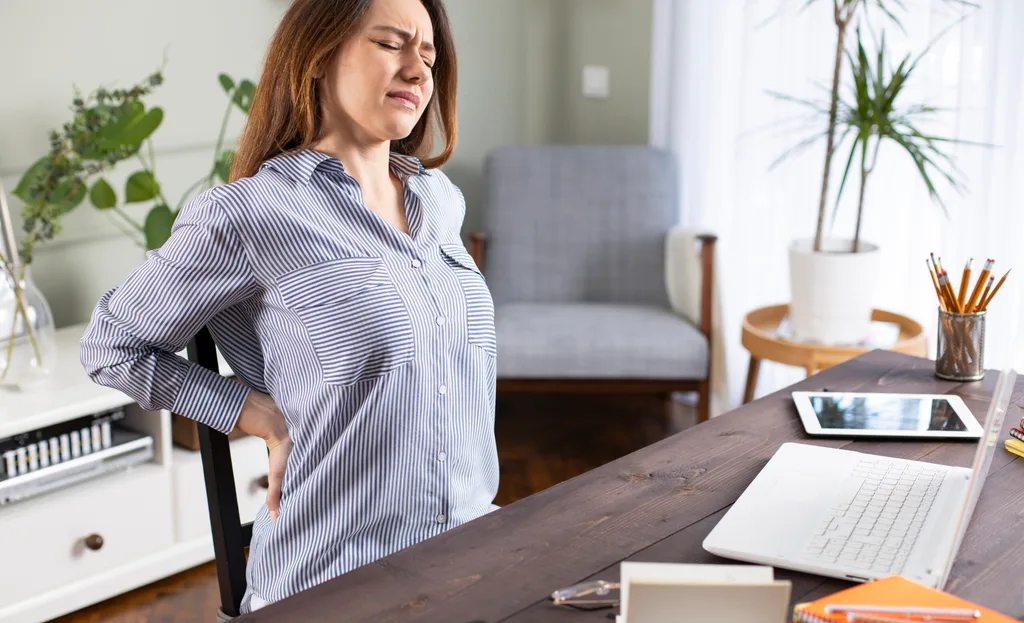Do you ever have a sharp pain when you move your neck? Does the pain spread to your back, shoulders and/or arms?
Chances are that the more hunched we sit at our desks or stare chin-first into our smart phones or computers, the more likely we are to suffer from ‘tech-neck’.
That’s the new buzz term for an increasingly common condition caused by spending too much time on our devices.
COVID-19 has driven most of us from our well-designed office spaces, where the ergonomics of how we work (that is, the safety and comfort of our work areas) is taken into account.
Now, we’re more likely to be sitting on a dining chair at the dinner table, where we are now at greater risk of not just tech neck, but also mid and lower back pain because of incorrect posture.
Jean Hailes physiotherapist Amy Steventon says it is possible to minimise your risks by following a step-by-step guide for setting up an ergonomically safe home workplace.

The longer you work from home, you may be noticing your body getting used to the lack of activity.
(Image: Getty)Of course, a safe home workplace isn’t just about posture. Our new working arrangements highlight the need to look after our emotional as well as our physical wellbeing.
We may be working in isolation, but we can still tap into the team spirit we used to enjoy in the office by staying in regular touch with our colleagues.
“I think it’s also very important for us to enjoy some fresh air – open up those windows, take a stroll in your garden, take regular breaks from the screen,” says Ms Steventon.
Ms Steventon says it is also important to establish boundaries between our work and home life.
“Structure the day so that you have a start time and a finish time,” she says.

You’d be forgiven for thinking you can and should be getting comfy while working from home.
(Image: Getty)The new work dynamic also provides women with the opportunity to incorporate pelvic floor exercises into part of their regular exercise routine, which can help improve bladder and bowel health as well as reduce the risk of prolapse.
“Pelvic floor exercises are an effective way of preventing and treating incontinence and pelvic organ prolapse,” says Ms Steventon.
“With the change of your normal routine, now is a great time to make these exercises a daily habit.”
Here are Ms Steventon’s guidelines for getting yourself set up ergonomically safely to work at home.
Feet
• Set your feet flat on the floor. If you feel pressure on your thighs, use a footrest to raise your feet.
Knees
• When seated, your knees should be flexed at a 90-degree angle, thighs parallel to the floor. Ideally you should have about a 3-5 finger span between the chair edge and the back of your knee.
• Ensure there is some clearance between your thighs and the underside of your desk.
Chair
• The aim is a firmly cushioned back (lumbar) support. Sit back in your seat so it contours your back. You can use a cushion or a rolled-up towel to support the natural curve in your back. The weight should be taken firmly through the bones under your buttocks.
• Armrests are not a good idea if you are working continuously on the keyboard. They can push your shoulders up and cause tension in your shoulder muscles. If you do want armrests, they must fit below your work table.
• The seat is flat or sloping gently downwards towards the front.

Correct sitting posture is just as important at home as it is in the office.
(Image: Getty)Keyboard placement
• Your wrist position should be neutral, not held up, nor down or to the sides.
• Keyboard is placed just below elbow height.
• Elbows should be bent at about 90 degrees, and stay comfortably tucked in near your sides.
• The keyboard should be positioned so you can rest your forearms on the desk edge.
Screen placement
• Avoid bright light directly in front of or behind the screen.
• Distance – the screen should be an arm’s distance away.
• Height – the tool bar should be at or just below eye level. This means the top of the visual screen should be at the same level as your eyes when looking straight ahead.
• Position – directly in front of body to prevent twisting of the neck. If you are using two screens, equally sit in the midline.
• Tilt – neutral or slightly downward.

Remember: you’re likely still spending most of the day sitting down, so be sure to use your lunch break to do something that keeps your active.
(Image: Getty)Work techniques
• Desktop layout – are your regularly used items within arm’s reach?
• Change your working posture regularly – don’t sit for more than 30 minutes at a time.
• Regularly perform work break exercises and eye exercise routine. See our fact sheet for instructions. Print it out and stick it on the wall next to your workstation.
• If using a sit/stand workstation, adjust the height of the work surface so that your forearms are parallel to the floor when standing.
Dual monitors
The best set-up of the monitors will depend on the time spent looking at each monitor:
• Similar time spent on both – both screens should be placed side by side, angled towards you with the middle of the screens directly in front of you.
• Different times on each screen – the most frequently used monitor should be set up centrally in front of you. The other monitor should be positioned to one side so that only a very slight turn of the neck is needed to view the screen.
Laptops
They might be convenient for people on the go, but laptops should not be used for long periods of time on their own, says Ms Steventon.
“The ideal would be to use a separate keyboard, mouse and screen with your laptop and set them all at comfortable positions,” she says.
If you must use your laptop as your screen, lift it up so that the edge of the open screen is just below your eye height. And definitely don’t use your laptop on the couch or on the coffee table.
“Make sure it is properly set up at your desk,” says Ms Steventon. “It can be elevated by using boxes, plastic tubs or books. You don’t need a fancy laptop holder.”
This article originally appeared on the Jean Hailes website and has been republished with permission.
For more information on COVID-19 and looking after yourself, visit the Jean Hailes website.
This story is published as part of a promotion for Women’s Health Week, 7-11 September 2020, of which The Australian Women’s Weekly is a proud supporter. Find out more about this initiative here.






